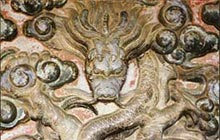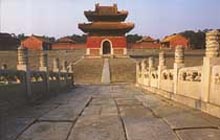
Finding commonality at Beijing's West Qing Tombs
by Guy Rubin
What is it that you, me and the last Qing dynasty Emperor, Puyi, could all have in common? Absolute power at the age of two? Two wives for our sixteenth birthday? A flawed come-back in our thirties? Or maybe it's that now we can all be buried together.
A commercial cemetery is the latest addition to the impressive Western Qing tombs. Having arranged for the relocation of Emperor Puyi's ashes to this newly opened cemetery, Hong Kong entrepreneur Zhang Shiyi is now selling burial lots in this fengshui-enhanced vicinity.
And not a bad idea it is too. For a visit to this beatific valley, adorned with more than seventy Imperial tombs, affords a rare pleasure. These Qing dynasty tombs echo and embolden their surrounding landscape. Austere courtyards mimic the graceful sweep of a wide, valley floor. While their raised "Soul Towers" lead your eyes upwards to the rugged mountains behind, their intricate, marble bridges invite you to glance down at their picturesque, moss-covered moats. The buildings' deference to their setting however, does not impugn their Imperial hauteur – for though they harmoniously blend in with their surroundings, their sheer size is spell-binding.
Unlike the Ming dynasty Emperors whose tombs are collected in one lush valley, the burial grounds of the Qing dynasty have been split between two main locations – the Eastern and Western Tombs. But why did the Qing dynasty require two separate burial sites?
 The reason dates back to a Dostoevskian tale of love and hate; of physical crime and spiritual punishment. When the Emperor Kangxi (r 1662-1722) bequeathed his empire to a younger son, Yongzheng (r. 1723-1735) usurped his father's throne and, to stave off their potential challenge, executed all his brothers as well as his father's ministers. Subsequently ridden with guilt, this ambitious ruler couldn't bear the thought of being buried next to his father. By selecting a burial site diametrically opposite the established Imperial Tombs, on the western as opposed to the eastern side of Beijing, Yongzheng instituted the Western Qing Tombs.
The reason dates back to a Dostoevskian tale of love and hate; of physical crime and spiritual punishment. When the Emperor Kangxi (r 1662-1722) bequeathed his empire to a younger son, Yongzheng (r. 1723-1735) usurped his father's throne and, to stave off their potential challenge, executed all his brothers as well as his father's ministers. Subsequently ridden with guilt, this ambitious ruler couldn't bear the thought of being buried next to his father. By selecting a burial site diametrically opposite the established Imperial Tombs, on the western as opposed to the eastern side of Beijing, Yongzheng instituted the Western Qing Tombs.
After comparing both sites, you will be in little doubt that Emperor Yongzheng was as frenziedly competitive in death as he had been in life. His tomb, the first at the Western Qing tombs, makes his father's at the Eastern look penny-pinching by comparison. For though Emperor Kangxi's tomb is expansive, his son's is built on an altogether more massive scale, reminiscent of the imposing majesty of the Forbidden City's southern courtyards. Its aesthetic merit lies as much in its appealing form as it does in embodying the unquestioning authority of its all-powerful occupant. Ironic then that so great an achievement should be inspired by so petty an ambition.
This narrow-mindedness is counterbalanced by the largesse of the second Emperor to be buried at the Western Qing Tombs, Emperor Jiaqing (r.1796-1820). Unwilling to surpass and thereby call into question the glory of his ancestor, Emperor Jiaqing thought it politic only to equal him. Except that he took his idea to an unnecessary extreme.
His tomb, Changling, relinquishing all individuality, is to every degree an exact copy of that of Emperor Yongzheng. So much so that when we arrived there, our navigator bet another friend 100 dollars that we'd taken the wrong turn and had, in error, returned to Yongzheng's tomb. It was an easy mistake to make. For the design of the bridges, the positioning of the well-preserved outhouses, even the brown mule and the souvenir stalls in front of the ticket office looked precisely the same – as if an age-old hoax were being intentionally perpetuated to the present day. Our bewilderment only intensified as, strolling though the tomb, we confirmed its similarity to the tiniest detail.
Jiaqing's Empress, fortunately, had no such pretensions to modesty. Her immaculate tomb next door, at Changxiling (Western Changling), sports the only Echo Wall I have ever had the joyful opportunity of testing. Indeed, as promised by Chinese guides at Beijing's ever crowded Temple of Heaven, if a message is whispered on one side of the circular wall, this will be perfectly audible to someone standing on the other. And by altering your position within the centre of the circular wall, you can adjust the number of echoes returned to you. Great fun when it works.
 Having spent two days exploring its curiosities, we were thoroughly charmed by this 800 km² Qing dynasty burial site. So pleasant is its setting and so magisterial its tombs that we could deeply sympathize with Emperor Puyi's last words, whispered to his wife, Li Shuxian, as he lay dying of cancer in 1967. "Please, please bury my ashes at the side of my adoptive father," he pleaded. It is wonderful that, after so sad a life, his last wish came true.
Having spent two days exploring its curiosities, we were thoroughly charmed by this 800 km² Qing dynasty burial site. So pleasant is its setting and so magisterial its tombs that we could deeply sympathize with Emperor Puyi's last words, whispered to his wife, Li Shuxian, as he lay dying of cancer in 1967. "Please, please bury my ashes at the side of my adoptive father," he pleaded. It is wonderful that, after so sad a life, his last wish came true.
As it could for you on down payment of $40,000.
Getting there
The most direct route to the Western Qing Tombs is to drive south west along the "Jingshi" highway, which links Beijing to Shijiazhuang. After about 80km, on arrival at Gaobeidian, head west for Yixian. The tombs are 16km west of Yixian on highway 112. Expect the journey from central Beijing to take over 3 hours.
original publication May 2000, Chinanow.com